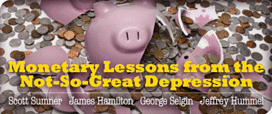For my last comment in the conversation portion of our exchange I want to mention how much I have enjoyed and learned from the discussion. I expressed my admiration for Scott Sumner in my initial contribution, and I will add to that my amazement at his ability to respond calmly, rapidly, and in detail to every query or objection raised, including nearly all those made in the comments he receives on his blog. I don’t know how he does it; I couldn’t reply that copiously even if I devoted every waking hour to the activity. As for George Selgin, those who have read my review of his latest book know how much I respect his work. And James Hamilton’s frequent posts at Econbrowser have been some of the most useful explanations and depictions of the Fed’s machinations over the last year or more. He and the others have all brought great insights to the discussion.
I conclude with an elaboration on why the distinction between monetary and velocity shocks deserves far more attention than Scott is willing to give it. The fundamental economic question about business cycles, although often unarticulated, is whether they are primarily market failures or government failures and, if they are market failures, whether government can do anything to alleviate them. This was the basic issue that divided Austrians and orthodox Monetarists on one side from traditional Keynesians on the other. Nearly all other macro differences stemmed from their answers to this question, despite the fact that the conclusions of any particular economist may have had no explicit political motivation. Consider the scrap heap of abandoned Keynesian fallacies — secular stagnation, exhaustion of investment opportunities, administered prices, totally endogenous money stock, etc., etc. — or the fact that New Keynesians have now embraced inflexible prices and wages, the very neoclassical explanation for cyclical unemployment that the early Keynesians rejected. There has been a collective, if unconscious, effort on the part of Keynesians to opportunistically seize whatever handy argument will prove that depressions or recessions require government intervention.
The distinction between money and velocity goes to the heart of this debate. Unless one embraces a pure, real business cycle approach, in which depressions and recessions are neither market failures nor government failures but economically optimal, then one must blame either government mismanagement of the monetary and financial system, erratic velocity driven by irrational bubbles and “animal spirits,” or some combination of the two. Lumping the two together not only obscures the fundamental issue, but also biases the answer toward the view that some government involvement is necessary. The more we get enmeshed in technical controversies over rules versus discretion, over inflation versus interest-rate versus nominal GDP targeting, and other secondary minutiae that simply assumes the necessity of a government central bank, however fascinating they may be, the more we lose sight of the central question of what does in fact cause the business cycle.
Scott’s last reply to me echoes Hamilton’s initial denigration of the equation of exchange (sometimes misleadingly called “the quantity equation”) because there are alternative definitions of M and therefore V. Multiple definitions of M and V merely reflect differences in how we organize our thoughts about the evidence. Thus, if we focus on the behavior of M1 and M2 from 1930 to 1933 during the Great Depression, we observe the bank panics causing a dramatic fall in the money stock. But if instead we focus on the monetary base, we will describe the panics as significantly decreasing base velocity (that is, increasing base money demand). In algebraic terms, VmKm = Vb, where the subscripts m and v refer respectively to broader definitions of money or the base, and K is the relevant multiplier for whatever M we are using.[1] If Km falls dramatically, ceteris paribus, Vb must be falling. Notice also without a sufficient change in the multiplier, the two velocities always move in the same direction.
These alternative ways of describing the same phenomenon should enhance our understanding, rather than bewilder us, as is clear from Friedman and Schwartz’s sophisticated handing of these matters in their Monetary History.[2] Their narrative about the depression is quite clear; they accuse the Fed of pursuing an actively tight policy prior to the onset of the banking panics in October 1930. Once the bank panics began, the Fed failed to counteract the falling multiplier with a sufficient expansion of the base. When the Fed finally expanded the base, it was too little and too late. Which measure is better depends on both convenience and what questions we are asking. What we should be looking at to understand the Great Moderation and the current recession is a puzzle to be explored[3], not brushed under the rug with a tautological definition of “monetary shocks.”
In the final analysis, I find the quest for better, self-enforcing central-bank rules naïve. When the market fails (as it often does), the alleged solution is more (or better) government regulation. And when the government fails, the alleged solution is more (or better) government regulation. This asymmetry, a dramatic illustration of Harold Demsetz’s nirvana fallacy, has already made the financial system one of the most, if not the most, highly regulated and subsidized sectors in the U.S. economy. It is high time to reverse the trend.
Notes
[1] The money multiplier is defined as Km = M/B, where B is the monetary base. If you substitute that definition into the above equation, you get MVm = BVb, which must be true, because both sides of the new equation are equal to nominal GDP.
[2] Milton Friedman and Anna Jacobson Schwartz, A Monetary History of the United States, 1867-1960 (Princeton: Princeton University Press, 1963).
[3] As David Henderson and I have attempted to do in our Cato Briefing. (http://www.cato.org/pub_display.php?pub_id=9756).

